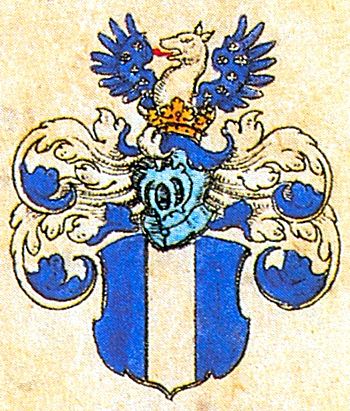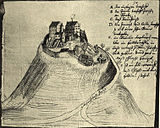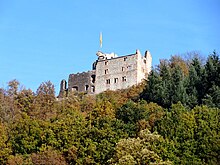County of Hohengeroldseck
|
Territory in the Holy Roman Empire |
|
|---|---|
| County of Hohengeroldseck | |
| coat of arms | |

|
|
| map | |

|
|
| Alternative names | Imperial rule Hohengeroldseck |
| Arose from | Reign of Hohengeroldseck |
| Ruler / government | Count |
| Today's region / s | DE-BW |
| Parliament | 1 curiate vote on the Swabian Count's Bank |
| Reichskreis | Swabian Empire |
| District council | 1 curial vote on the count's bench |
| Capitals / residences | Seelbach |
| Dynasties | von der Leyen |
| Denomination / Religions | Roman Catholic |
| Language / n | German |
| surface | 126 km² |
| Residents | 4,500 (1,800) |
| Incorporated into | Principality of the Leyen (1806); Grand Duchy of Baden (1819) |
| See also | Gentlemen von Geroldseck |
The County of Hohengeroldseck was a county of the Holy Roman Empire of the German Nation , which was ruled by the von der Leyen family. The county existed from 1711 until the end of the empire in 1806. From 1806 to 1813, the territory was a member of the Rhine Confederation as the Principality of von der Leyen .
territory
The county was near Lahr in the Black Forest and consisted of the main town of Seelbach , Hohengeroldseck Castle and the villages listed below. It covered 126 km² with around 4 500 inhabitants around 1800. The county belonged to the Swabian Empire . The county bordered the imperial cities of Gengenbach and Zell am Harmersbach in the north and the principality of Fürstenberg in the east . In the south, the margraviate Hochberg and the office of Ettenheim of the bishopric of Strasbourg were the neighbors and in the west lay the Nassau rule Lahr and the Baden-Baden rule Mahlberg .
history
The Lords of Geroldseck can be identified in the Ortenau since the beginning of the 12th century . After the death of Mr. Walther von Geroldseck in 1277, there were divisions due to inheritance disputes. In 1426 the area of the Lahr-Mahlberg line fell to the Counts of Moers-Saar Werden and came to Baden until 1497 . The territories of Heinrich von Geroldseck, who from then on called himself Count von Veldenz because of his marriage to Agnes von Veldenz , came under Austrian feudal rule in 1504.
Anna Maria von Hohen-Geroldseck († 1649) was after the death of her father, Jakob von Hohen-Geroldseck († 1634), the only heiress of the von Geroldseck family . The Habsburgs viewed the entire Hohengeroldseck rule as a fief that had reverted to them and ignored the heiress' claims to the allodial property contained therein ; the emperor now enfeoffed the counts of Kronberg with rule. Anna Maria married the margrave of Baden-Durlach , Friedrich V. In Article IV, § 27 of the Peace Treaty of Osnabrück it was stipulated that Anna Maria should be given the goods she claimed upon presentation of real documents. Anna Maria appointed Friedrich as her heir, but he, too, could not come into possession of the inherited allodial property until the end of his life, as the Habsburgs and the power they enfeoffed Adolf Otto Graf von und zu Kronberg repeatedly postponed the execution of the contractual provisions and lodged new appeals. Already in 1692 the Counts of Kronberg died out with Adolf Otto in the male line.
Now, after an unsuccessful attempt by the Margrave of Baden, Friedrich VII. Magnus , to annex the area (1692–1697), Hohengeroldseck was ruled as a Habsburg fiefdom by the von der Leyen dynasty from 1697 onwards . In 1711 it received the dignity of imperial counts and was accepted into the Swabian imperial counts' college. The rule became imperial rule with a seat and vote in the Reichstag.
Thanks to the relationship with Arch Chancellor Dalberg , Hohengeroldseck initially remained independent during the Napoleonic period, but the area did not experience any expansion. Now completely surrounded by Baden territory, Hohengeroldseck became the smallest member of the Rhine Confederation under Philipp Franz in 1806 as the Principality of von der Leyen .
After the Battle of the Nations near Leipzig , Prince Philipp, who had lived in Paris for years , did not join the coalition led by Prussia , Russia and Austria . Therefore Hohengeroldseck was drafted on December 12th, 1813 as "ownerless land" and placed under the administration of the victorious powers. When Prince Philipp later tried to join the coalition, this was now denied him.
Hohengeroldseck came to Austria through the Congress of Vienna in 1815 . At the Aachen Congress in 1818, it came to the Grand Duchy of Baden through an exchange of territory : Baden received Hohengeroldseck, in return it ceded the Steinfeld office to Austria, which in turn left it to the Kingdom of Bavaria . Hohengeroldseck was handed over to Baden on November 25, 1819. The area was initially administered as the "Provisional Office Hohengeroldseck" until it was added to the Lahr Office on March 1, 1831.
List of the Imperial Counts of Hohengeroldseck
| Reign | Surname | Born | Died | ancestry |
|---|---|---|---|---|
| 1705-1739 | Karl Kaspar | July 19, 1655 | November 30, 1739 | Barons von der Leyen-Adendorf |
| 1739-1760 | Friedrich Ferdinand | January 7, 1709 | February 16, 1760 | Son of the previous one |
| 1760-1775 | Franz Karl | August 26, 1736 | September 26, 1775 | Son of the previous one |
| 1775-1806 / 13 | Philipp Franz | August 1, 1766 | November 23, 1829 | Son of the previous one |
Since Philipp Franz was only 9 years old when his father died in 1775, his mother Marianne von der Leyen took over the reign from 1775 to 1793.
economy
Fruit growing and arable farming were practiced in the county. In the cattle industry, the pigs were in the foreground. In the hamlet of Geroldseck there was a lead mine and in Emersbach there was silver mining in the St. Lendlins mine.
places
| local community | Remarks | coat of arms |
|---|---|---|
| Seelbach | Capital of the county with about 500 inhabitants around 1800; with Dautenstein Castle and Seelbach Castle , as well as Litschental and Steinbach; today's district of Wittelbach did not belong to the county |

|
| Kuhbach | with Brudertal |

|
| Prinzbach | with Emersbach |

|
| Reichenbach | with Eichberg, Gereut, Giesenhof, Langeck, Poche, Schindelhöfe |

|
| Schoenberg |

|
|
| Schuttertal |

|
See also
literature
- Gerhard Köbler : Historical lexicon of the German countries. The German territories and imperial immediate families from the Middle Ages to the present. 5th, completely revised edition. CH Beck, Munich 1995, ISBN 3-406-39858-8 , p. 196 f.
- Johannes Jacobus Reinhard : Pragmatic history of the house of Geroldseck, as well as their imperial rule Hohengeroldseck, Lahr and Mahlberg in Swabia . Frankfurt / Leipzig 1766 Digitized by Google
- Christoph Bühler: Geroldseck (with Lahr-Mahlberg) . In: Meinrad Schaab , Hansmartin Schwarzmaier (ed.) U. a .: Handbook of Baden-Württemberg History . Volume 2: The Territories in the Old Kingdom. Edited on behalf of the Commission for Historical Regional Studies in Baden-Württemberg . Klett-Cotta, Stuttgart 1995, ISBN 3-608-91466-8 , pp. 412-416.
- Oskar Kohler: Geroldseck under the Lords of Cronberg and von der Leyen and the end of rule . In: Die Ortenau , 43rd annual volume, 1963, pp. 72–97, ub.uni-freiburg.de
- Friedrich Facius: Hohengeroldseck, a Black Forest territory in higher politics 1603-1831 . In: Schau-ins-Land Volume 90 (1972), pp. 61–79 online at Freiburg University Library
- Philipp Ludwig Hermann Röder : Geographical Statistical-Topographical Lexicon of Swabia. Ulm 1800, Volume 1 Google digitized ; Volume 2 Google digitized version
Individual evidence
- ^ Phillip Ludwig Hermann Röder: Geographisches Statistisch-Topographisches Lexikon von Schwaben . Ulm 1800, Volume 1, Col. 702
- ^ Peace treaty in the Internet portal "Westphalian History"
- ↑ s. Kohler p. 97
- ↑ Entry on discover regional studies online - leobw
- ↑ Entry on discover regional studies online - leobw
- ^ Phillip Ludwig Hermann Röder: Geographisches Statistisch-Topographisches Lexikon von Schwaben . Ulm 1800, Volume 1, Col. 702-704
- ↑ old coats of arms; the coats of arms of the new unitary municipalities are not used
- ↑ Seelbach . Discover regional studies online - leobw
- ^ Phillip Ludwig Hermann Röder: Geographisches Statistisch-Topographisches Lexikon von Schwaben . Ulm 1801, Volume 2, Col. 684/685
- ↑ Litschental . Discover regional studies online - leobw
- ↑ Kuhbach . Discover regional studies online - leobw
- ↑ Brudertal . Discover regional studies online - leobw
- ↑ Prinzbach . Discover regional studies online - leobw
- ↑ Entry on discover regional studies online - leobw
- ↑ Reichenbach . Discover regional studies online - leobw
- ↑ Eichberg . Discover regional studies online - leobw
- ↑ Schönberg . Discover regional studies online - leobw
- ↑ Schuttertal . Discover regional studies online - leobw


